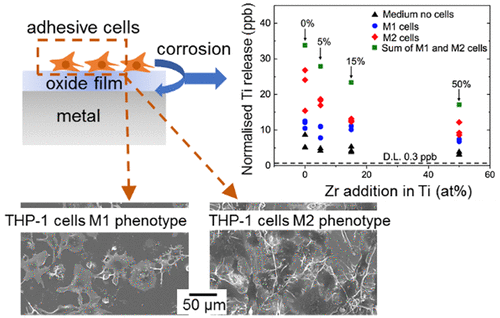当前位置:
X-MOL 学术
›
ACS Biomater. Sci. Eng.
›
论文详情
Our official English website, www.x-mol.net, welcomes your
feedback! (Note: you will need to create a separate account there.)
Effect of Zr Addition on the Corrosion of Ti in Acidic and Reactive Oxygen Species (ROS)-Containing Environments
ACS Biomaterials Science & Engineering ( IF 5.4 ) Pub Date : 2018-02-19 00:00:00 , DOI: 10.1021/acsbiomaterials.7b00882 Yue Zhang 1 , Alison J. Davenport 1 , Bernard Burke 2, 3 , Nina Vyas 2 , Owen Addison 2, 4
ACS Biomaterials Science & Engineering ( IF 5.4 ) Pub Date : 2018-02-19 00:00:00 , DOI: 10.1021/acsbiomaterials.7b00882 Yue Zhang 1 , Alison J. Davenport 1 , Bernard Burke 2, 3 , Nina Vyas 2 , Owen Addison 2, 4
Affiliation

|
The effect of systematic Zr additions on the corrosion behavior of Ti was studied in both acidic and reactive oxygen species (ROS) containing environments, including macrophage cell culture, simulating inflammation associated with metallic implants. Electrochemical measurements on commercially pure (CP) Ti, Zr, and TiZr alloys showed that increasing Zr additions progressively enhanced Ti passivity in both acidic (HCl) and oxidative (H2O2) environments. However, a Ti50Zr alloy was found with increased pitting susceptibility. Corrosion was also evaluated using mass-spectrometry to determine metal ion release following exposure of the alloys to THP-1 macrophage cell cultures, transformed into either their M1 (inflammatory states) or M2a (tissue repair states) phenotypes. The magnitude of ion release was reduced with increasing Zr contents, consistent with electrochemical observations. Nevertheless, optimized Zr content in Ti should balance both passivity and pitting resistance.
中文翻译:

Zr对含酸性和活性氧(ROS)的环境中Ti腐蚀的影响
在含酸性和活性氧(ROS)的环境(包括巨噬细胞培养)中研究了系统添加Zr对Ti腐蚀行为的影响,模拟了与金属植入物相关的炎症。对商用纯(CP)Ti,Zr和TiZr合金的电化学测量表明,增加的Zr添加量会逐渐增强酸性(HCl)和氧化性(H 2 O 2)环境。但是,发现Ti50Zr合金的点蚀敏感性增加。还使用质谱法评估了腐蚀情况,以确定合金暴露于THP-1巨噬细胞细胞培养物后转化为M1(炎症状态)或M2a(组织修复状态)表型后金属离子的释放。随Zr含量的增加,离子释放的量减少,这与电化学观察结果一致。但是,Ti中最佳的Zr含量应在钝化性和抗点蚀性之间取得平衡。
更新日期:2018-02-19
中文翻译:

Zr对含酸性和活性氧(ROS)的环境中Ti腐蚀的影响
在含酸性和活性氧(ROS)的环境(包括巨噬细胞培养)中研究了系统添加Zr对Ti腐蚀行为的影响,模拟了与金属植入物相关的炎症。对商用纯(CP)Ti,Zr和TiZr合金的电化学测量表明,增加的Zr添加量会逐渐增强酸性(HCl)和氧化性(H 2 O 2)环境。但是,发现Ti50Zr合金的点蚀敏感性增加。还使用质谱法评估了腐蚀情况,以确定合金暴露于THP-1巨噬细胞细胞培养物后转化为M1(炎症状态)或M2a(组织修复状态)表型后金属离子的释放。随Zr含量的增加,离子释放的量减少,这与电化学观察结果一致。但是,Ti中最佳的Zr含量应在钝化性和抗点蚀性之间取得平衡。











































 京公网安备 11010802027423号
京公网安备 11010802027423号